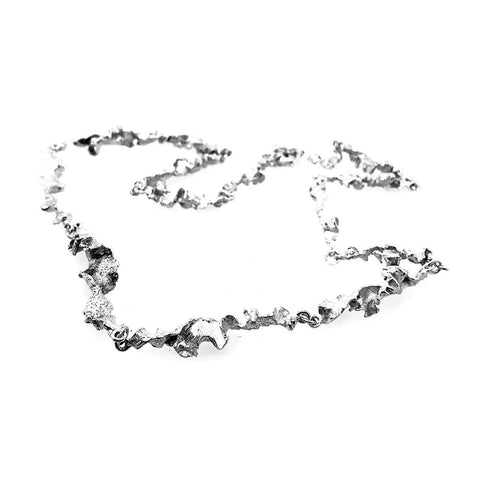
Mexican jewelry, What Is Special About It?
Have you heard about "Mexican" or "Taxco" silver jewelry?
You might be thinking: what is this all about? What’s different or special about it?
Here I briefly present a history of how the silver jewelry industry originated in Taxco and its most important characteristics, so that you can understand the relevance of its legacy which stands to these days, despite the challenge of worldwide mass production jewelry.
I promise, it's interesting, just a little bit of history and then... straight to the point: the jewelry!
At the beginning of the twentieth century, the Mexican silver industry experienced an extraordinary resurgence. North American Intellectuals were drawn to Mexico to witness the social changes that were taking place as a result of the Revolution. William Spratling, a young architect from New Orleans, was part of that cultural and artistic community, who had the opportunity to visit Mexico and travel around its many colonial towns. This inspired him to write books, draw sketches, but specially to develop a fascination and love for this country. After some years, he even decided to give up his life in the United States, to settle down in a picturesque town where silver mining had been the support of the local economy for over 400 years, yet without benefiting its own people.
Thanks to his friendship with the US American Ambassador to Mexico Dwight Morrow; the Undersecretary of Education of Mexico Moisés Sáenz and the Mexican muralist Diego Rivera, Spratling learned about this economic situation in Taxco, and he decided to start something with the social purpose of rising out the natives of poverty.
That’s how the “Taller de Las Delicias” was born.

In 1930, right before the opening of his “Taller de Las Delicias”, Spratling was passing through a very difficult financial situation; that, along with his social ideals, gave him the strength to start his little workshop with the purpose to provide a livelihood for the local population, and where he set forth the concept of a “cultural renaissance”. But he had something clear from the beginning: he didn’t intend to be a silversmith. He knew he needed to find the most skilled people to work for him and create a “school” where the knowledge had to be passed through apprenticeships. With that in mind, he went into the hills to find an old man who mastered the silversmithing craft and started passing his knowledge to others. As a result, Spratling would create and design intricate and unique pieces, while the Mexican silversmiths and apprentices would masterfully interpret his ideas and transform them into beautiful silver masterpieces. He employed hundreds of local artisans to create a thriving local industry.
A new era was born in Taxco. Vast numbers of designs poured out of the workshops where there seemed to be no limits on creativity and experimentation. Scholars, artists, politicians, intellectuals, traveled to Taxco for its beauty and to witness the realization of social and economic change derived from the silver industry. People such as John Ford, Lana Turner, Paulette Goddard, Marilyn Monroe, Aldous Huxley, are amongst those who made their way to Taxco and brought home stunning silver jewelry and decorative objects, mostly of them embellished with “exotic” Aztec or Mayan motifs.

Something that can be attributed to Spratling’s success is that from the beginning, he acknowledged that: “In Mexico, silversmithing has always been considered a folk art, since it has traditionally been produced for domestic or personal use. I am convinced that folk art is basically possible only when you have a group of people who are happily unburdened with instruction, people who are free to focus and feed the need to produce with their hands in order to make a living. Their imagination is thus poured in an untrammeled way into their products, whether it is silver or the weaving of simple cotton textiles, hand-blown glass or ceramics.” (“File on Spratling”, pg. 75).
Insistence on handwork and the value placed on experimentation impelled the achievement of the Mexican silver movement. Designers and craftsmen drew on pre-Columbian art, the Arts and Crafts movement, Art Deco, and modernism, resisting slavish imitation in favor of technical and formal innovation.
William Spratling, Margot de Taxco, Antonio Castillo, Héctor Aguilar, Antonio Pineda, Enrique Ledesma along with many others, hand created jewelry masterpieces that put Mexico silver products on the world scene.
 Today, Mexican silver art continues to be made and sold in extraordinary quantity. Older silver pieces have a more complicated, heavier look and pre-Columbian motifs are usually part of them. The labor involved in making the jewelry, the weight of the silver used, the skill of the craftsperson, and the intricacy of the design, are distinctive elements of Mexican silver jewelry.
Today, Mexican silver art continues to be made and sold in extraordinary quantity. Older silver pieces have a more complicated, heavier look and pre-Columbian motifs are usually part of them. The labor involved in making the jewelry, the weight of the silver used, the skill of the craftsperson, and the intricacy of the design, are distinctive elements of Mexican silver jewelry.
Quality silver items will have a hallmark or trademark somewhere on the pieces, that can help you identify where the piece was made, the silversmith who made it and the approximate age of the piece.
 Mexican master silversmiths (maestros plateros) are renowned for their impressive craftsmanship, design and imagination. All of them started their training at a young age, playing at the workshops of their parents, later to start their apprenticeship by performing basic techniques that would evolve through the years, until they learn how to be a silversmith. This process can usually take from ten to fifteen years.
Mexican master silversmiths (maestros plateros) are renowned for their impressive craftsmanship, design and imagination. All of them started their training at a young age, playing at the workshops of their parents, later to start their apprenticeship by performing basic techniques that would evolve through the years, until they learn how to be a silversmith. This process can usually take from ten to fifteen years.
Though nowadays it's undeniable that handcrafted jewelry faces big challenges, because the mass production has taken a big toll on this market. People have chosen to go for cheap/disposable costume jewelry over the one that still preserves the flavor, hard work and looks of a handmade product.
Many of the early silversmiths who worked for Spratling developed their own workshops and became famous in their own right. Nowadays you can still find their grandchildren innovating, designing and creating beautiful objects and jewelry in silver, combining different techniques and materials such as precious or semi-precious stones, ceramic, leather, rubber, wood, to enhance their creations, improve the look and attractiveness of the jewelry, making it more eye appealing to their customers.
The influence and legacy of William Spratling is undeniable. He had a passion for collecting pre-Hispanic artifacts and he even owned reproductions of important codices as part of an extensive library on pro-Columbian art. He had the opportunity to visit numerous archeological sites as he knew many of the notable archaeologists and scholars in Mexico. All this is reflected in his work and has influenced the designers in Taxco and throughout the country. These powerful artistic works reveal the fascination with indigenous culture, which is shared by those who make the silver and by those who buy it.

Beautiful representations of Mexican motifs in silver jewelry
It is important to note that high-quality sterling silver jewelry from Taxco comes in different styles. So many exciting collections of daring designs are handcrafted in Taxco; not everything is related to ethnic or pre-Hispanic motifs.
The distinctive character of modern Mexican silver jewelry is that skilled and talented designers artfully blend traditional Mexican forms with contemporary designs, incorporating their unique vision, marked by technical and stylistic innovation. The outcome is the production of amazing jewelry of outstanding quality and workmanship, that surprises and seduces women who appreciate jewelry in an artistic way and think of it as a way to express their emotions and unique personality.

Buying silver jewelry from Taxco means supporting the local economy and the silversmithing tradition that for decades has distinguished this unique colonial town and gained it a name in the international stage. It means helping to preserve the trade by allowing people to keep working the traditional way, involving the younger generations to be trained the same way their parents were trained.
For me as a Mexican and owner of Nueve Sterling, showcasing and promoting these outstanding products to the world, is an opportunity to feel like I am sharing part of the history and culture of my country, which makes me feel very proud and extremely happy.
Nueve Sterling is your gateway to Mexican Silver jewelry from the magical town of Taxco: handmade pieces product of the hard work of talented people, that share a common history and the commitment to keep working the same way as the founders of this great industry did, nearly a century ago.
Share

